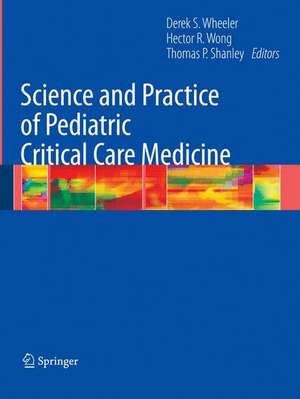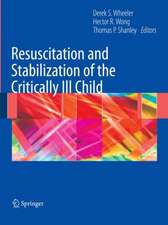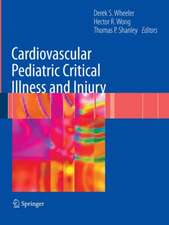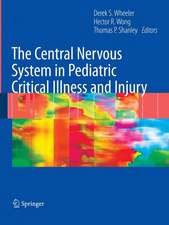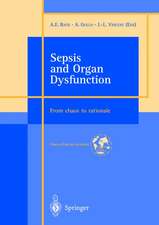Science and Practice of Pediatric Critical Care Medicine
Editat de Derek S. Wheeler, Hector R. Wong, Thomas P. Shanleyen Limba Engleză Paperback – 28 dec 2008
Preț: 375.13 lei
Preț vechi: 394.87 lei
-5% Nou
Puncte Express: 563
Preț estimativ în valută:
71.78€ • 75.13$ • 59.74£
71.78€ • 75.13$ • 59.74£
Carte tipărită la comandă
Livrare economică 31 martie-14 aprilie
Preluare comenzi: 021 569.72.76
Specificații
ISBN-13: 9781848009202
ISBN-10: 1848009208
Pagini: 199
Ilustrații: XII, 199 p.
Dimensiuni: 210 x 279 x 15 mm
Greutate: 0.58 kg
Ediția:2009
Editura: SPRINGER LONDON
Colecția Springer
Locul publicării:London, United Kingdom
ISBN-10: 1848009208
Pagini: 199
Ilustrații: XII, 199 p.
Dimensiuni: 210 x 279 x 15 mm
Greutate: 0.58 kg
Ediția:2009
Editura: SPRINGER LONDON
Colecția Springer
Locul publicării:London, United Kingdom
Public țintă
Professional/practitionerDescriere
The ? eld of critical care medicine is in the midst of a dramatic change. Technological and s- enti? c advances during the last decade have resulted in a fundamental change in the way we view disease processes, such as sepsis, shock, acute lung injury, and traumatic brain injury. Pediatric intensivists have been both witness to and active participants in bringing about these changes. As the understanding of the pathogenesis of these diseases reaches the cellular and molecular levels, the gap between critical care medicine and molecular biology will disappear. It is imperative that all physicians caring for critically ill children in this new era have a th- ough understanding of the applicability of molecular biology to the care of these patients at the bedside in order to keep up with the rapidly evolving ? eld of critical care medicine. To the same extent, the practice of critical care medicine is in the midst of fundamental change. In keeping with the Institute of Medicine’s report “Crossing the Quality Chasm,” the care of critically ill and injured children needs to be safe, evidence-based, equitable, ef? cient, timely, and fami- centered [1,2]. In the following pages, these changes in our specialty are discussed in greater scope and detail, offering the reader fresh insight into not only where we came from, but also where we are going as a specialty.
Cuprins
Development of Pediatric Critical Care Medicine – How Did We Get Here and Why?, Epidemiology of Critical Illness, Ethics in the PICU, The Patient’s Family in the PICU, Scoring Systems in Critical Care, Outcomes and Quality: Definitions, Assessment, and Analysis, Pediatric Intensive Care Unit Administration, Nursing Care in the PICU, The Physician-Scientist In The PICU, Resident And Nurse Education In The Pediatric Intensive Care Unit, Evidence-based Medicine in the Pediatric Intensive Care Unit, Patient Safety in the Pediatric Intensive Care Unit, Pediatric Critical Care in Developing Countries, The PICU of the Future, Molecular Biology in the Pediatric Intensive Care Unit, Genetic Polymorphisms in Critical Care and Illness, Signal Transduction Pathways in Critical Illness and Injury, Proinflammatory and anti-inflammatory mediators in critical illness, Endogenous cytoprotective mechanisms, Ischemia-Reperfusion Injury
Recenzii
From the reviews:
"Evolution of pediatric critical care programs and outcome issues are emphasized in this softcover book. Fellows and/or practitioners treating pediatric critical illness are an appropriate audience for this work. … This is a good read on the history and biology of the field." (David J. Dries, Doody’s Review Service, February, 2009)
"Evolution of pediatric critical care programs and outcome issues are emphasized in this softcover book. Fellows and/or practitioners treating pediatric critical illness are an appropriate audience for this work. … This is a good read on the history and biology of the field." (David J. Dries, Doody’s Review Service, February, 2009)
Textul de pe ultima copertă
The field of critical care medicine is in the midst of a dramatic change. Technological and scientific advances during the last decade have resulted in a fundamental change in the way we view disease processes, such as sepsis, shock, acute lung injury, and traumatic brain injury. Pediatric intensivists have been both witness to and active participants in bringing about these changes and it is imperative that all physicians caring for critically ill children in this new era have a thorough understanding of the applicability of these modern developments to the care of patients at the bedside and to keep up with the rapidly evolving field of critical care medicine.
The care of critically ill and injured children needs to be safe, evidence-based, equitable, efficient, timely, and family-centered. Science and Practice of Pediatric Critical Care Medicine discusses these changes in the specialty in greater scope and detail, offering the reader fresh insight into not only where we came from, but also where we are going as a specialty. Thus, this book is designed for all involved in the management of the pediatric critically ill patient, from physicians, residents and fellows in critical care, pulmonology, cardiology and pediatricians to specialist nurses and support personnel on the pediatric critical care unit and all medical professionals that are involved in the management of these patients.
The care of critically ill and injured children needs to be safe, evidence-based, equitable, efficient, timely, and family-centered. Science and Practice of Pediatric Critical Care Medicine discusses these changes in the specialty in greater scope and detail, offering the reader fresh insight into not only where we came from, but also where we are going as a specialty. Thus, this book is designed for all involved in the management of the pediatric critically ill patient, from physicians, residents and fellows in critical care, pulmonology, cardiology and pediatricians to specialist nurses and support personnel on the pediatric critical care unit and all medical professionals that are involved in the management of these patients.
Caracteristici
Includes supplementary material: sn.pub/extras
